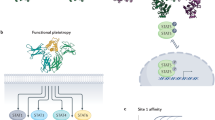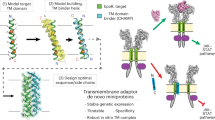Abstract
We describe a method for the rational design of more effective therapeutic proteins using amino acid substitutions that reduce receptor binding affinity in intracellular endosomal compartments, thereby leading to increased recycling in the ligand-sorting process and consequently resulting in longer half-life in extracellular medium. We demonstrate this approach for granulocyte colony-stimulating factor by using computationally predicted histidine substitutions that switch protonation states between cell-surface and endosomal pH. Molecular modeling of binding electrostatics indicates two different single-histidine mutants that fulfill our design requirements; experimental assays demonstrate that each mutant indeed exhibits an order-of-magnitude increase in medium half-life along with enhanced potency due to increased endocytic recycling.
This is a preview of subscription content, access via your institution
Access options
Subscribe to this journal
Receive 12 print issues and online access
$209.00 per year
only $17.42 per issue
Buy this article
- Purchase on Springer Link
- Instant access to full article PDF
Prices may be subject to local taxes which are calculated during checkout


Similar content being viewed by others
Accession codes
References
Lauffenburger, D.A., Fallon, E.M. & Haugh, J.M. Scratching the (cell) surface: cytokine engineering for improved ligand/receptor trafficking dynamics. Chem. Biol. 5, R257–R263 (1998).
French, A.R., Tadaki, D.K., Niyogi, S.K. & Lauffenburger, D.A. Intracellular trafficking of epidermal growth factor family ligands is directly influenced by the pH sensitivity of the receptor/ligand interaction. J. Biol. Chem. 270, 4334–4340 (1995).
Cama, A. et al. Two mutant alleles of the insulin receptor gene in a family with a genetic form of insulin resistance: a 10 base-pair deletion in exon 1 and a mutation substituting serine for asparagine 462. Hum. Genet. 95, 174–182 (1995).
Ebner, R. & Derynck, R. Epidermal growth factor and transforming growth factor-α: differential intracellular routing and processing of ligand-receptor complexes. Cell Regul. 2, 599–612 (1991).
Waterman, H., Sabanai, I., Geiger, B. & Yarden, Y. Alternative intracellular routing of ErbB receptors may determine signaling potency. J. Biol. Chem. 273, 13819–13827 (1998).
French, A.R. & Lauffenburger, D.A. Controlling receptor/ligand trafficking: effects of cellular and molecular properties on endosomal sorting. Ann. Biomed. Eng. 25, 690–707 (1997).
Reddy, C.C., Niyogi, S.K., Wells, A., Wiley, H.S. & Lauffenburger, D.A. Engineering epidermal growth factor for enhanced mitogenic potency. Nat. Biotechnol. 14, 1696–1699 (1996).
Fallon, E.M., Liparoto, S.F., Lee, K.J., Ciardelli, T.L. & Lauffenburger, D.A. Increased endosomal sorting of ligand to recycling enhances potency of an interleukin-2 analog. J. Biol. Chem. 275, 6790–6797 (2000).
Horan, T. et al. Dimerization of the extracellular domain of granulocyte-colony stimulating factor receptor by ligand binding: a monovalent ligand induces 2:2 complexes. Biochemistry 35, 4886–4896 (1996).
Horan, T.P., Martin, F., Simonet, L., Arakawa, T. & Philo, J.S. Dimerization of granulocyte-colony stimulating factor receptor: the Ig plus CRH construct of granulocyte-colony stimulating factor receptor forms a 2:2 complex with a ligand. J. Biochem. (Tokyo) 121, 370–375 (1997).
Fukunaga, R., Ishizaka-Ikeda, E., Pan, C.-X., Seto, Y. & Nagata, S. Functional domains of the granulocyte colony-stimulating factor receptor. EMBO J. 10, 2855–2865 (1991).
Aritomi, M. et al. Atomic structure of the GCSF-receptor complex showing a new cytokine-receptor recognition scheme. Nature 401, 713–717 (1999).
Layton, J.E., Hockman, H., Sheridan, W.P. & Morstyn, G. Evidence for a novel in vivo control mechanism of granulopoiesis: mature cell-related control of a regulatory growth factor. Blood 74, 1303–1307 (1989).
Morstyn, G., Dexter, T.M. & Foote, M. (eds). Filgrastim (r-metHuG-CSF) in Clinical Practice, Edn. 2 (Marcel Dekker, New York, 1998).
Tanokura, M. 1H-NMR study on the tautomerism of the imidazole ring of histidine residues. Biochim. Biophys. Acta 742, 576–585 (1983).
Yang, A.-S. & Honig, B. On the pH dependence of protein stability. J. Mol. Biol. 231, 459–474 (1993).
Layton, J.E. et al. Interaction of granulocyte colony-stimulating factor (G-CSF) with its receptor: evidence that Glu19 of G-CSF interacts with Arg288 of the receptor. J. Biol. Chem. 274, 17445–17451 (1999).
Reidhaar-Olson, J.F., De Souza-Hart, J.A. & Selick, H.E. Identification of residues critical to the activity of human granulocyte colony-stimulating factor. Biochemistry 35, 9034–9041 (1996).
Fallon, E.M. & Lauffenburger, D.A. Computational model for effects of ligand/receptor binding properties on interleukin-2 trafficking dynamics and T cell proliferation response. Biotechnol. Prog. 16, 905–916 (2000).
Berman, H.M. et al. The Protein Data Bank. Nucleic Acids Res. 28, 235–242 (2000).
Layton, J.E., Hall, N.E., Connell, F., Venhorst, J. & Treutlein, H.R. Identification of ligand-binding site III on the immunoglobulin-like domain of the granulocyte colony-stimulating factor receptor. J. Biol. Chem. 276, 36779–36787 (2001).
Layton, J.E., Iaria, J., Smith, D.K. & Treutlein, H.R. Identification of a ligand-binding site on the granulocyte colony-stimulating factor receptor by molecular modeling and mutagenesis. J. Biol. Chem. 272, 29735–29741 (1997).
Sarkar, C.A. Cytokine engineering through ligand/receptor dynamics: a study on granulocyte colony-stimulating factor. PhD thesis, Massachusetts Institute of Technology, Cambridge, MA (2002).
Brünger, A.T. & Karplus, M. Polar hydrogen positions in proteins: empirical energy placement and neutron diffraction comparison. Proteins 4, 148–156 (1988).
Brooks, B.R. et al. CHARMM: a program for macromolecular energy, minimization, and dynamics calculations. J. Comput. Chem. 4, 187–217 (1983).
Kangas, E. & Tidor, B. Optimizing electrostatic affinity in ligand-receptor binding: theory, computation, and ligand properties. J. Chem. Phys. 109, 7522–7545 (1998).
Dunbrack, R.L. & Karplus, M. Backbone-dependent rotamer library for proteins: application to side-chain prediction. J. Mol. Biol. 230, 543–574 (1993).
Sitkoff, D., Sharp, K.A. & Honig, B. Accurate calculation of hydration free energies using macroscopic solvent models. J. Phys. Chem. 98, 1978–1988 (1994).
Leach, A.R. & Lemon, A.P. Exploring the conformational space of protein side chains using dead-end elimination and the A* algorithm. Proteins 33, 227–239 (1998).
Desmet, J., De Maeyer, M., Hazes, B. & Lasters, I. The dead-end elimination theorem and its use in protein side-chain positioning. Nature 356, 539–542 (1992).
Goldstein, R.F. Efficient rotamer elimination applied to protein side-chains and related spin glasses. Biophys. J. 66, 1335–1340 (1994).
Hendsch, Z.S. & Tidor, B. Electrostatic interactions in the GCN4 leucine zipper: substantial contributions arise from intramolecular interactions enhanced on binding. Protein Sci. 8, 1381–1392 (1999).
Gilson, M.K., Sharp, K.A. & Honig, B.H. Calculating the electrostatic potential of molecules in solution: method and error assessment. J. Comput. Chem. 9, 327–335 (1988).
Sharp, K.A. & Honig, B. Electrostatic interactions in macromolecules: theory and applications. Annu. Rev. Biophys. Biophys. Chem. 19, 301–332 (1990).
Gilson, M.K. & Honig, B.H. Calculation of electrostatic potentials in an enzyme active site. Nature 330, 84–86 (1987).
Aiyar, A., Xiang, Y. & Leis, J. Site-directed mutagenesis using overlap extension PCR. Methods Mol. Biol. 57, 177–191 (1996).
Lu, H.S. et al. Folding and oxidation of recombinant human granulocyte colony stimulating factor produced in Escherichia coli. J. Biol. Chem. 267, 8770–8777 (1992).
Kelleher, C.A. et al. Binding of iodinated recombinant human GM-CSF to the blast cells of acute myeloblastic leukemia. Leukemia 2, 211–215 (1988).
Kuwabara, T., Kobayashi, S. & Sugiyama, Y. Kinetic analysis of receptor-mediated endocytosis of G-CSF derivative, nartograstim, in rat bone marrow cells. Am. J. Physiol. Endocrinol. Metab. 34, E73–E84 (1996).
Khwaja, A., Carver, J., Jones, H.M., Paterson, D. & Linch, D.C. Expression and dynamic modulation of the human granulocyte colony-stimulating factor receptor in immature and differentiated myeloid cells. Br. J. Haematol. 85, 254–259 (1993).
French, A.R., Sudlow, G.P., Wiley, H.S. & Lauffenburger, D.A. Postendocytic trafficking of epidermal growth factor receptor complexes is mediated through saturable and specific endosomal interactions. J. Biol. Chem. 269, 15749–15755 (1994).
Nicholls, A., Sharp, K.A. & Honig, B. Protein folding and association: insights from the interfacial and thermodynamic properties of hydrocarbons. Proteins 11, 281–296 (1991).
Acknowledgements
We thank D. Brems and H. Lodish for vital input and encouragement; J. Caravella, E. Fallon, F. Frankel, E. Kangas, K.D. Wittrup, and D. Wu for fruitful discussions; and E. McCulloch for the OCI/AML1 cell line. This work was supported by a Hertz Foundation fellowship to C.A.S., National Institutes of Health grant GM56552 to B.T., and a grant from the Amgen/MIT Partnership to D.A.L.
Author information
Authors and Affiliations
Corresponding authors
Rights and permissions
About this article
Cite this article
Sarkar, C., Lowenhaupt, K., Horan, T. et al. Rational cytokine design for increased lifetime and enhanced potency using pH-activated “histidine switching”. Nat Biotechnol 20, 908–913 (2002). https://doi.org/10.1038/nbt725
Received:
Accepted:
Published:
Issue Date:
DOI: https://doi.org/10.1038/nbt725
This article is cited by
-
Proximity-enabled covalent binding of IL-2 to IL-2Rα selectively activates regulatory T cells and suppresses autoimmunity
Signal Transduction and Targeted Therapy (2023)
-
An anti-CD98 antibody displaying pH-dependent Fc-mediated tumour-specific activity against multiple cancers in CD98-humanized mice
Nature Biomedical Engineering (2022)
-
SpySwitch enables pH- or heat-responsive capture and release for plug-and-display nanoassembly
Nature Communications (2022)
-
Differential trafficking of ligands trogocytosed via CD28 versus CTLA4 promotes collective cellular control of co-stimulation
Nature Communications (2022)
-
A topological refactoring design strategy yields highly stable granulopoietic proteins
Nature Communications (2022)



